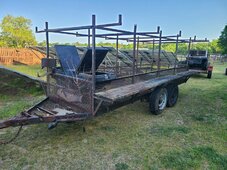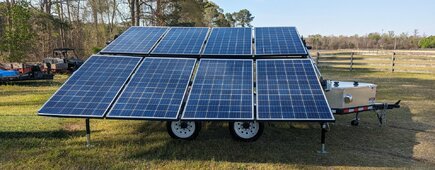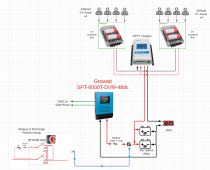RememberTheMagic
New Member
- Joined
- Sep 26, 2021
- Messages
- 47
What I am trying to do is make a Solar Trailer that will be used on a small construction site (or to power a small log cabin home) where there is no grid available. The idea is to use a PV array that is mounted on the trailer along with the onboard Battery on the trailer to power the load(s).
Looking for 240/120 USA Split Phase
In this application I want it to use the onboard PV Solar array as the primary source, and the onboard Battery (when solar is not enough, dark outside, cloudy days, etc..), or better yet PV Solar Panels and Battery at the same time; HOWEVER when the trailer is not being used for the OFF GRID scenario, I want to be able to take the trailer home and plug it into the grid. In this scenario I want it to use the PV Solar Array only. Effectively at this point, the Solar Trailer becomes a ground-mount PV array.
I heard Growatt and MPP has such a solution but I can’t seem to get a straight answer on either. I would like to budget less than $2,500 on the inverter so that rules out SolArk, etc..
I am not married to Growatt or MPP, they are typically just a cost-effective product. Worse on either of those manufacturers I can't determine what model would work, if any.
I am going to use my own battery pack (and Charger) so that I don’t have to spend thousands on what most manufacturers want for their battery Packs. I have a Midnite MPPT Charge Controller, a Daly BMS and a 16-cell LifePo4 Prismatic Cells already working together as a pack that has proven to be reliable.
Any help is greatly appreciated, I am trying to get this done in the next 2 weeks, anyone got a solution? Used or New, make, model =o)
Update 4/2/2024 - Finally Finished the trailer!

Day one...
Finished - deployed

Looking to move forward ASAP
Looking for 240/120 USA Split Phase
In this application I want it to use the onboard PV Solar array as the primary source, and the onboard Battery (when solar is not enough, dark outside, cloudy days, etc..), or better yet PV Solar Panels and Battery at the same time; HOWEVER when the trailer is not being used for the OFF GRID scenario, I want to be able to take the trailer home and plug it into the grid. In this scenario I want it to use the PV Solar Array only. Effectively at this point, the Solar Trailer becomes a ground-mount PV array.
I heard Growatt and MPP has such a solution but I can’t seem to get a straight answer on either. I would like to budget less than $2,500 on the inverter so that rules out SolArk, etc..
I am not married to Growatt or MPP, they are typically just a cost-effective product. Worse on either of those manufacturers I can't determine what model would work, if any.
I am going to use my own battery pack (and Charger) so that I don’t have to spend thousands on what most manufacturers want for their battery Packs. I have a Midnite MPPT Charge Controller, a Daly BMS and a 16-cell LifePo4 Prismatic Cells already working together as a pack that has proven to be reliable.
Any help is greatly appreciated, I am trying to get this done in the next 2 weeks, anyone got a solution? Used or New, make, model =o)
Update 4/2/2024 - Finally Finished the trailer!

Day one...

Finished - deployed

Looking to move forward ASAP
Last edited:




